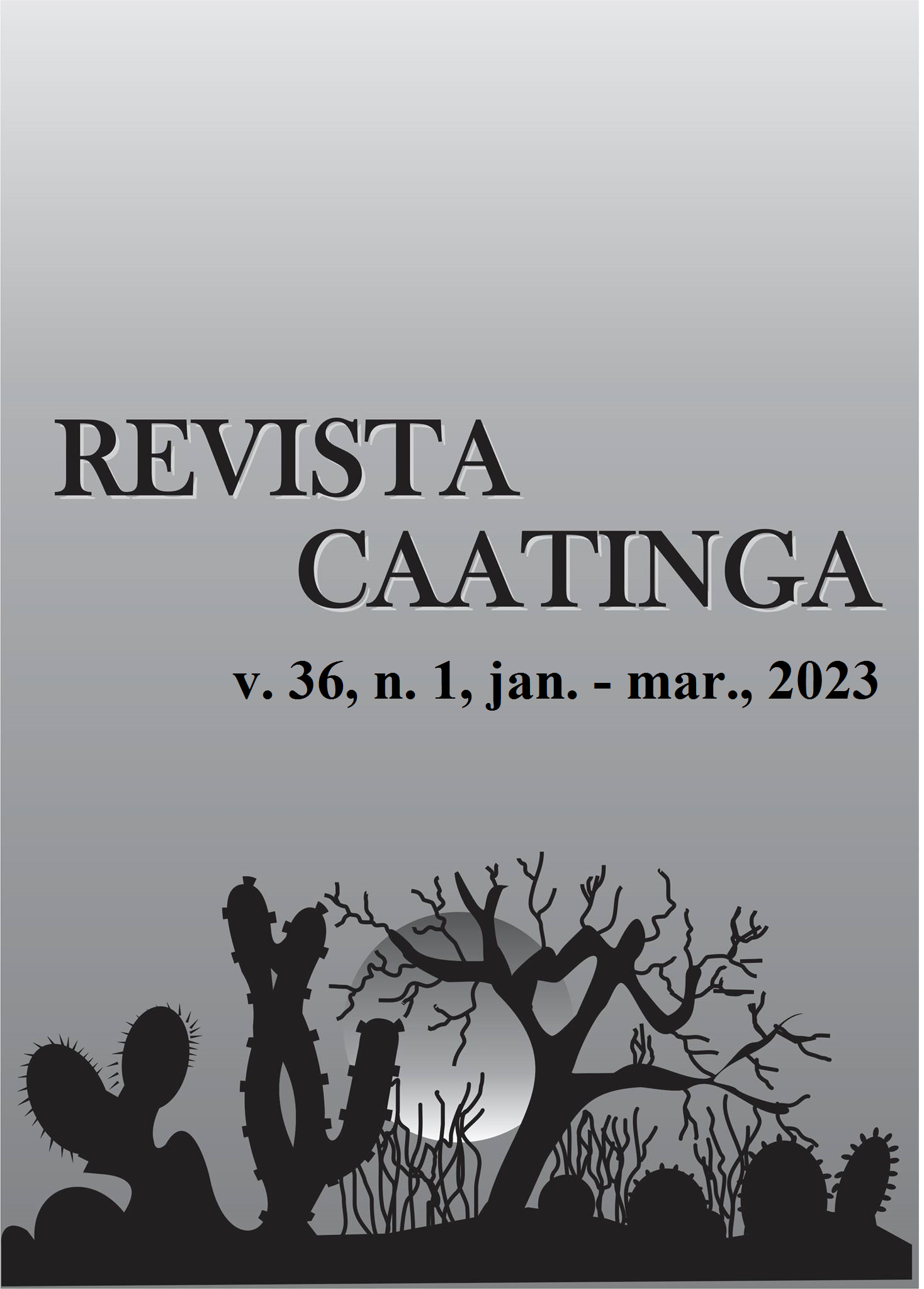Characterization of cowpea cultivars for grain size, color, and biofortification
DOI:
https://doi.org/10.1590/1983-21252023v36n122rcKeywords:
Vigna unguiculata. Iron. Zinc. Protein. Grain weight. Grain color.Abstract
Cowpea crops have high socioeconomic importance in the Northeast region of Brazil. These crops generate employment and income; in addition, it is an excellent source of protein, minerals, vitamins, and dietary fiber, and contributes to the food security of thousands of people. Biofortification of cowpea with iron, zinc, and proteins can contribute to prevent the higher hunger. The objective of this work was to assess iron, zinc, and protein contents in cowpea grains of different cultivars and the effect of grain size and color on the contents of these nutrients. Twenty-four cultivars with variation in size and color of the seed coat were evaluated. Iron contents ranged from 7.12 to 8.60 mg 100 g-1, with an overall mean of 7.75 mg 100 g-1. Zinc contents ranged from 4.46 to 4.93 mg 100 g-1, with an overall mean of 4.71 mg 100 g-1. Protein contents ranged from 31.50 to 36.24 g 100 g-1, with an overall mean of 33.57 g 100 g-1. Grain size ranged from 13.55 to 37.88 g, with an overall mean of 21.50 g. The cultivars Caldeirão, BRS-Guariba, and Pingo-de-Ouro-1-2 have higher iron contents; BRS-Aracê and BRS-Imponente have higher zinc contents; BR-14-Mulato, BRS-Guariba, BRS-Aracê, and BRS-Inhuma, have higher protein contents; and BR-3-Tracuateua and BRS-Imponente have larger grain sizes. The size and color of the seed coat do not influence the iron, zinc and protein contents of the evaluated cowpea cultivars.
Downloads
References
AOAC - Association of Official Analytical Chemists. Official Methods of Analysis of AOAC International. 20. ed. Rockville: AOAC International, 2016.
CARDONA-AYALA, C. E. et al. Adaptability and stability for iron and zinc in cowpea by AMMI analysis. Revista Caatinga, 34: 590-598, 2021.
CARVALHO, A. F. U. et al. R. Nutritional ranking of 30 Brazilian genotypes of cowpeas including determination of antioxidant capacity and vitamins. Journal of Food Composition and Analysis, 26: 81-88, 2012.
COELHO, R. C. et al. Expanding information on the bioaccessibility and bioavailability of iron and zinc in biofortified cowpea seeds. Food Chemistry, 15: 1-9, 2021.
CONAB - Companhia Nacional de Abastecimento. Acompanhamento da safra brasileira: grãos, safra 2020/2021, 10o levantamento, julho de 2021. Brasília, DF: CNAB, v. 8, n. 10, p. 12-14. Disponível em: https://www.conab.gov.br/info-agro/safras/graos>. Acesso em: 19 Abr. 2021.
CRUZ, C. D. GENES - a software package for analysis in experimental statistics and quantitative genetics. Acta Scientiarum. Agronomy, 35: 271-276, 2013.
DIAS-BARBOSA, C. Z. M. C. et al. Seleção de linhagens elite de feijão-caupi de porte semiereto biofortificadas com ferro e zinco. Brazilian Journal of Development, 6: 19807-19814, 2020.
DIAS-BARBOSA, C. Z. M. C. et al. Selection of cowpea elite lines for iron and zinc biofortification. Current Nutrition & Food Science, 17: 48-58, 2021.
FREIRE FILHO, F. R. Feijão Caupi no Brasil: produção, melhoramento genético, avanços e desafios. 1. ed. Teresina, PI: Embrapa Meio-Norte, 2011. 84 p.
FREIRE FILHO, F. R. et al. A cultura: aspectos socioeconômicos. In: DOVALE, J. C.; BERTINI, C.; BORÉM, A. (Eds.) Feijão- caupi: do plantio a colheita. Viçosa, MG: Editora UFV, 2017. v. 1, cap. 1, p. 9-34.
GERRANO, A. S. et al. Selection of cowpea genotypes based on grain mineral and total protein content. Acta Agriculturae Scandinavica, Section B – Soil & Plant Science, 69: 155-166, 2019.
GONÇALVES, F. V. et al. Protein, phytate and minerals in grains of commercial cowpea genotypes. Annals of the Brazilian Academy of Sciences, 92: 1-16, 2020.
MARINHO, J. T. S. et al. Agronomic performance of cowpea genotypes in southwestern Brazilian Amazon. Pesquisa Agropecuária Brasileira, 56: 1-9, 2021.
MOURA, J. O. et al. Path analysis of iron and zinc contents and others traits in cowpea. Crop Breeding and Applied Biotechnology, 12: 245-252, 2012.
OLIVEIRA, D. S. V. et al. Adaptability and stability of the zinc density in cowpea genotypes through GGE-Biplot method. Revista Ciência Agronômica, 48: 783-791, 2017.
R DEVELOPMENT CORE TEAM. R: A language and environmental for statistical computing. 2014. Disponível em: <http://www.R-project.org>. Acesso em: 10 mar. 2021.
ROCHA, M. M.; DAMASCENO-SILVA, K. J.; MENEZES-JÚNIOR, J. A. N. Cultivares. In: DoVALE, J. C.; BERTINI, C.; BORÉM, A. (Eds.). Feijão-caupi: do plantio à colheita. Viçosa, MG: Editora UFV, 2017. v. 1, cap. 6, p. 113-142.
SANTOS, C. A. F.; BOITEUX, L. S. Breeding biofortified cowpea lines for semi-arid tropical areas by combining higher seed protein and mineral levels. Genetics and Molecular Research, 13: 6782-6789, 2013.
SANTOS, C. A. F.; BOITEUX, L. S. Genetic control and transgressive segregation of zinc, iron, potassium, phosphorus, calcium, and sodium accumulation in cowpea (Vigna unguiculata) seeds. Genetics and Molecular Research, 14: 259-268, 2015.
SARRUGE, J. R.; ΗAAG, H. P. Análises químicas em plantas. Piracicaba, SP: Editora Livroceres, 1974. 56 p.
WENG, Y. et al. Evaluation of seed protein content in USDA cowpea germplasm. HortScience, 54: 814-817, 2019.
Downloads
Published
Issue
Section
License
Os Autores que publicam na Revista Caatinga concordam com os seguintes termos:
a) Os Autores mantêm os direitos autorais e concedem à revista o direito de primeira publicação, com o trabalho simultaneamente licenciado sob a Licença Creative Commons do tipo atribuição CC-BY, para todo o conteúdo do periódico, exceto onde estiver identificado, que permite o compartilhamento do trabalho com reconhecimento da autoria e publicação inicial nesta revista, sem fins comerciais.
b) Os Autores têm autorização para distribuição não-exclusiva da versão do trabalho publicada nesta revista (ex.: publicar em repositório institucional ou como capítulo de livro), com reconhecimento de autoria e publicação inicial nesta revista.
c) Os Autores têm permissão e são estimulados a publicar e distribuir seu trabalho online (ex.: em repositórios institucionais ou na sua página pessoal) a qualquer ponto antes ou durante o processo editorial, já que isso pode gerar alterações produtivas, bem como aumentar o impacto e a citação do trabalho publicado (Veja O Efeito do Acesso Livre).







